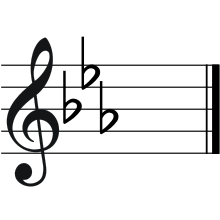E-flat major
E-flat major (or the key of E-flat) is a major scale based on E♭, with the pitches E♭, F, G, A♭, B♭, C, and D. Its key signature has three flats: B, E, and A. Its relative minor is C minor, while its parallel minor is E♭ minor (or enharmonically D♯ minor).
 | |
| Relative key | C minor |
|---|---|
| Parallel key | E-flat minor |
| Dominant key | B-flat major |
| Subdominant | A-flat major |
| Component pitches | |
| E♭, F, G, A♭, B♭, C, D | |
The E-flat major scale is:
Characteristics
The key of E-flat major is often associated with bold, heroic music, in part because of Beethoven's usage. His Eroica Symphony, Emperor Concerto and Grand Sonata are all in this key. Also Beethoven's (hypothetical) 10th symphony is in the key of E-flat major. But even before Beethoven, Francesco Galeazzi identified E-flat major as "a heroic key, extremely majestic, grave and serious: in all these features it is superior to that of C."[1]
Three of Mozart's completed horn concertos and Joseph Haydn's Trumpet Concerto are in E-flat major and so is Anton Bruckner's Fourth Symphony with its prominent horn theme in the first movement. Another notable heroic piece in the key of E-flat major is Richard Strauss's A Hero's Life. The heroic theme from the Jupiter movement of Holst's The Planets is in E-flat major. Mahler's vast and heroic Eighth Symphony is in E-flat and his Second Symphony also ends in the key.
This is not to say that, in the Classical period, E-flat major was only for bombastic music with brass. "E-flat was the key Haydn chose most often for [string] quartets, ten times in all, and in every other case he wrote the slow movement in the dominant, B-flat."[2] Or "when composing church music and operatic music in E-flat major, [Joseph] Haydn often substituted cors anglais for oboes in this period", and also in the Symphony No. 22 in E-flat major.[3]
For Mozart, E-flat major was associated with Freemasonry; "E-flat evoked stateliness and an almost religious character."[4]
Elgar chose to write his Variation IX "Nimrod," from the Enigma Variations, in Eb major, the relative key to G minor, the key of the original theme. Its strong, yet vulnerable character has led the piece to become a staple at funerals, especially in Great Britain.
Shostakovich used the E-flat major scale to sarcastically evoke military glory in his Symphony No. 9 .[5]
Well-known compositions in this key
- Johann Sebastian Bach
- Ludwig van Beethoven
- Septet for Strings and Woodwinds, Op. 20
- Symphony No. 3, Op. 55 "Eroica"
- Piano Concerto No. 5, Op. 73 "Emperor"
- Piano Sonata No. 4, Op. 7 "Grand Sonata"
- Piano Sonata No. 18, Op. 31/3 "The Hunt"
- Piano Sonata No. 26, Op. 81a "Les Adieux"
- Sextet for Horns and String Quartet, Op. 81b
- String Quartet No. 10, Op. 74
- String Quartet No. 12, Op. 127
- Max Bruch
- Scottish Fantasy in E-flat major, Op. 46
- Anton Bruckner
- Frédéric Chopin
- Antonín Dvořák
- Edward Elgar
- Variations on an Original Theme, Variation IX "Nimrod"
- Joseph Haydn
- Franz Liszt
- Gustav Mahler
- Felix Mendelssohn
- Wolfgang Amadeus Mozart
- Franz Schubert
- Robert Schumann
- Dmitri Shostakovich
- Jean Sibelius
- John Philip Sousa
- Pyotr Ilyich Tchaikovsky
- Anton Arensky
- 24 Morceaux caractéristiques Op. 36, no. 7 "Valse"
- Étude Op. 74, No. 7
- Moritz Moszkowski
- Étude de Virtuosité Op. 72, No. 7
- Stephen Heller
- Étude Op. 46, No. 19
- Felix Blumenfeld
- Prelude Op. 17, No. 19
- Ferrucio Busoni
- Prelude Op. 37, No. 19
Notes
- Francesco Galeazzi, Elementi teorico-practici di musica (1796) as translated to English in Rita Steblin, A History of Key Characteristics in the Eighteenth and Early Nineteenth Centuries. University of Rochester Press (1996): 111
- Paul Griffiths, The String Quartet. New York: Thames & Hudson (1983): 29
- David Wyn Jones, "The Symphonies of Haydn" in A Guide to the Symphony, ed. Robert Layton. Oxford: Oxford University Press
- Robert Harris, What to Listen for in Mozart. Simon & Schuster (2002): 174
- Fay, Laurel (1999). Shostakovich: A Life. Oxford University Press. ISBN 0-19-513438-9.